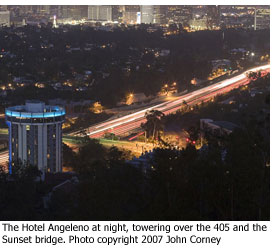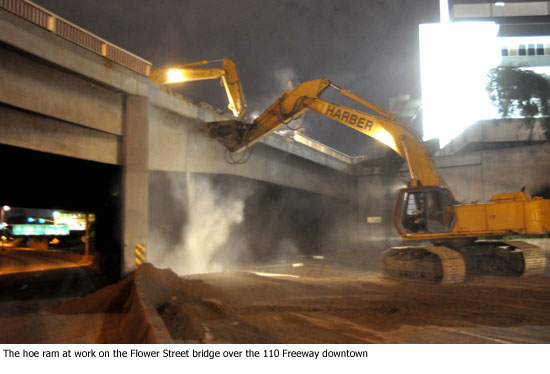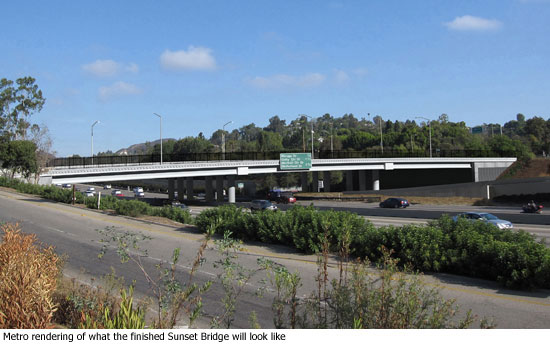Demolition time on Sunset
May 5, 2010
When the Sunset Boulevard bridge overpass to the 405 Freeway comes down, don’t expect a Vegas-style, imploding-the-Sands-Hotel kind of spectacle. This will be more of a chunk-by-chunk demolition—what one Metro official likens to taking apart a giant Lego structure.
But this is no child’s play.
The $1.034 billion I-405 Sepulveda Pass widening project enters a challenging new phase this week as workers prepare to demolish portions of the Sunset Bridge, one of three overpasses to be taken down and replaced with wider, upgraded structures in coming months. Up next are bridges at Skirball Center Drive (work slated to begin this fall) and Mulholland (scheduled to begin after the Skirball work starts.)
Although advance work on the Sunset bridge project starts Friday, the precise date for the demolition is up in the air, with the start likely to come this month, depending on how the prep work goes.
The bridge will have four lanes open to traffic during construction—two in each direction—but the prospect of the inevitable noise, dirt and traffic disruption has many in this tony neighborhood on edge. Adding to the concern is the beginning of work next week on a city Department of Water and Power water pipeline project that, for the next six months, will close a block-long stretch of Church Lane heading south from Sunset.
At the Luxe Hotel Sunset Boulevard, one of two upscale hotels located in the midst of the coming action, employees are used to staging enormous wedding and bar mitzvah receptions in the 300-guest ballroom and catering to the needs of high-profile guests reported to include celebrities such as Charlize Theron and Jennifer Love Hewitt.
But operating a hotel with two massive construction projects just outside the door?
“We are actually, honestly, scared,” says Seth Horowitz, who until recently was general manager of the Luxe, site of a community meeting earlier this week for members of local neighborhood associations seeking information on the projects. Metro representatives have met with officials of the Luxe and its nearby counterpart, Hotel Angeleno, and promised to stay in close communication to ensure that construction doesn’t interfere with upcoming big events at the hotels.
Even at the best of times, getting around the area can be tough. Horowitz said a guest at a “very important event” recently told him about battling rush hour traffic for 1-1/2 hours to reach the hotel from Paul Revere Middle School near Mandeville Canyon Road—less than three miles away. “That’s before they cut down the bridge,” Horowitz says.
 Eventually, that kind of surface street congestion should be helped by the freeway project, whose primary objective is to create a 10-mile northbound carpool lane on the 405 through the Sepulveda Pass—one of the most heavily-traveled corridors in the country. The rebuilt Sunset Bridge will be upgraded seismically and will be wider—120 feet, compared to 90 feet now—with 8 lanes instead of the current six and “higher capacity on- and off-ramps,” according to Metro.
Eventually, that kind of surface street congestion should be helped by the freeway project, whose primary objective is to create a 10-mile northbound carpool lane on the 405 through the Sepulveda Pass—one of the most heavily-traveled corridors in the country. The rebuilt Sunset Bridge will be upgraded seismically and will be wider—120 feet, compared to 90 feet now—with 8 lanes instead of the current six and “higher capacity on- and off-ramps,” according to Metro.
The new capacity could also help with concerns about freeway-bound cars backing up onto local streets. As for the long-running issue of freeway-ramp meter timing, a pilot program set to begin May 21 will examine whether turning the meters off during construction will improve traffic conditions.
Mike Barbour, Metro’s top executive on the project, acknowledges the area’s traffic congestion problems and the fact that residents will “kind of have to plan their lives around this work” for a while.” He says his agency is working to communicate alternative routes and detours, and to respond, whenever possible, to community suggestions for improving the situation. “If it becomes a complete mess out there,” he says, “obviously we’re going to correct that.”
More than anything, though, he says the goal is to get the contractor, Kiewit Pacific Co., to complete the work as quickly as possible. “Our big push is going to be to get it done sooner,” Barbour says.
In the meantime Metro has established a page dedicated to the Sunset Bridge demolition on its website and also is experimenting with an array of social media to get the word out. “I tweeted 14 times today, just because today there happened to be a lot of lane closures,” says Ned J. Racine, the project’s “new media officer.” In addition to Twitter and Facebook, the latest tool in Racine’s lineup is Nixle, an ad-free notification site used by law enforcement and other government agencies to communicate highly localized information to members of the public.
But cyber tools are not going to be enough to get the job done in the real world, even in this highly desirable corner of the real world, dotted as it is with such internationally known locales as the Getty, UCLA, Brentwood and Bel-Air. So for the demolition work, they’re bringing in a destruction tool called the “hoe ram”—a crane with a massive jackhammer attached. The contractor is “basically going to break the bridge apart with a huge jackhammer,” says Mark Van Gessel, Metro’s manager for the Sunset segment.
The work will take place in phases—between 6 and 9 nights of demolition followed by 10 months of construction on the southern end of the bridge, with a repeat of the same pattern on the northern side when the first half is finished. In all, some 12,000 tons of concrete will come down, to be pulverized onsite and recycled as “crushed miscellaneous base” and used as a building material on the project.
Segments of the freeway will be closed when demo work is taking place on the bridge overhead, as will streets including Sunset and Sepulveda. However, the work will be staggered so that the freeway and Sepulveda will not be closed at the same time.
Workers will start preparing for the job on Friday night, closing Sunset Boulevard and on-ramps near the Hotel Angeleno at 9 p.m. to establish new lane markings and a work zone to be completed by 6 a.m. Monday morning. Then they’ll start preparing the bridge for demolition: securing a major 34-inch water line inside the bridge; removing and bagging asbestos from around piping; and taking out the original wood forms so that the concrete can be recycled.
Cori Solomon, president of the Brentwood Glen Association, organized the meeting at the Luxe Hotel this week and invited her counterparts in the Westwood Hills Residents Association to take part as well. (Metro’s presentation is here, with slide 11 detailing Friday’s work.)
About 200 people showed up to voice concerns about noise, the double-whammy of the Church Lane water main work taking place at the same time the bridge job is underway, and the potential for construction to send new “cut through” traffic onto traditionally quiet residential streets.
Solomon, who’s lived in the neighborhood nearly 24 years, says her goal throughout the project is to “keep the community aware” and to find ways to make the situation “semi-livable” for residents.
“The board understands that it’s not going to be easy. It’s going to be a mess,” she says. “The thing is, it’s going to happen. You can’t stop it.”
And a philosophical attitude helps. “In the scheme of things, this freeway construction is a small speck in your life,” Solomon says. “In the end, it will hopefully be a little better, a little nicer.”
The project hotline number is (213) 922-3665. The next community meeting is scheduled for May 20, from 6-8 p.m. at The Getty. A fact sheet on the project, including a list of frequently asked questions, is here.
Posted 5-05-10














 405 bridge work causes a stink
405 bridge work causes a stink

